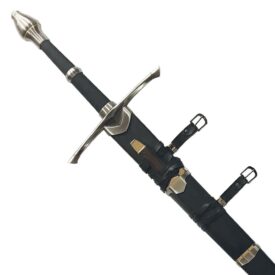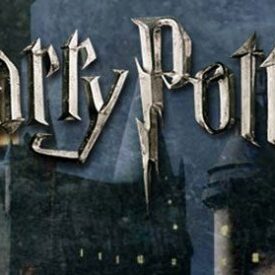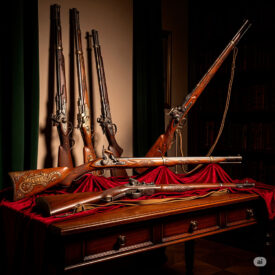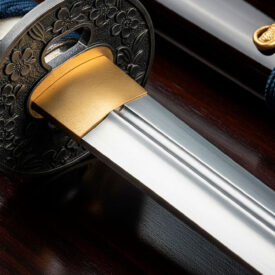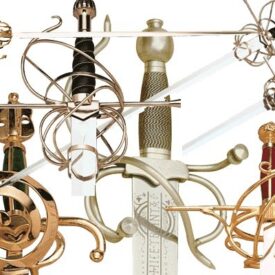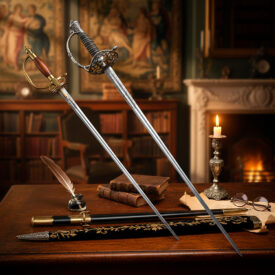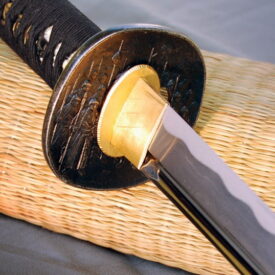Steel that tells stories: an epic look at Italian swords
What makes an Italian sword a cult object among collectors, fencing masters, and reenactors? It’s not just the edge: it’s the combination of design, social context, and masterful forging that made Italian steel a European benchmark. In this article, you will discover the most representative types, their historical evolution, production centers, fencing treatises that defined techniques, and, very importantly, how these pieces are reproduced today as functional replicas.
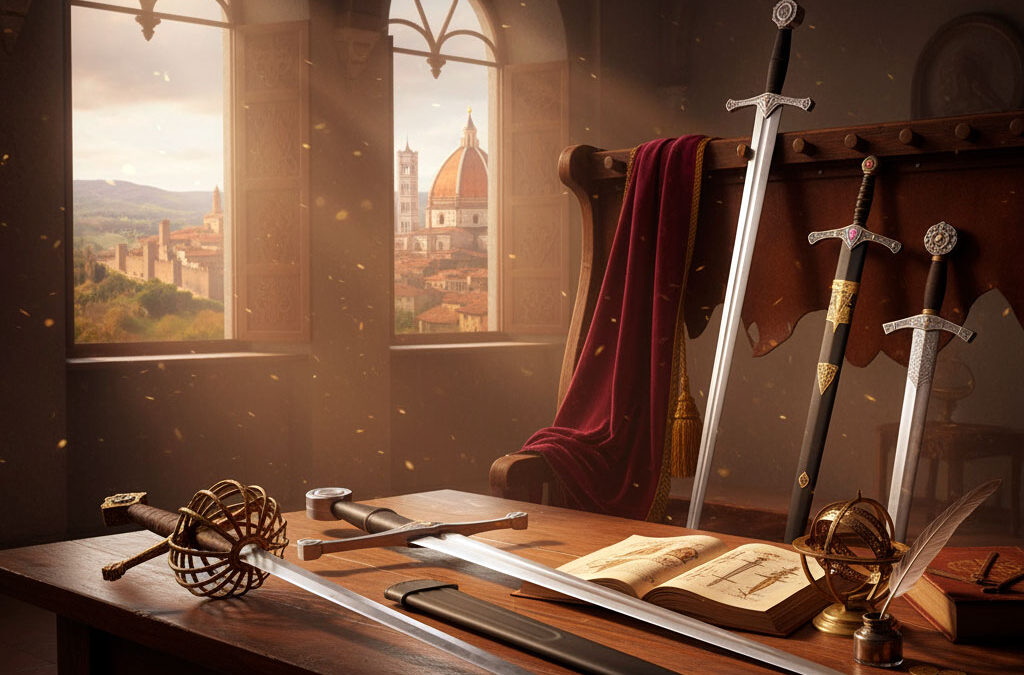
We will begin by setting the chronology to understand the thread of time. Then we will review the typologies (cinquedea, spada da lato, schiavona, rapier), look at technical comparisons, study materials and forging — including details of modern replicas — and conclude with conservation tips and the cultural relevance these blades maintain.
Timeline of Italian Swords
| Era | Event / Description |
|---|---|
| Late 15th century – early 16th century | |
| The Cinquedea | Originating from northern Italy (Emilia and Veneto). A civilian weapon and status symbol, with a short, heavy blade (35–60 cm) and up to five fingers wide near the hilt; decorated fuller on both sides and ivory grips. |
| Spada da lato (sidesword) | A versatile one-handed sword, effective in both cutting and thrusting. Wider and shorter blade than later rapiers; an evolutionary step between medieval swords and rapiers specialized in thrusting. |
| 16th – 17th centuries | |
| Schiavona | From Venice and used by the Schiavoni (Balkan mercenaries). Asymmetrical hilt of loops forming a semi-spiral handguard, “cat’s head” pommel, broad blade tapering towards the point with a longitudinal fuller; approx. 105 cm length and weight referred in the source as 1,125 grams. |
| Evolution of the Italian Rapier | The rapier became the dominant civilian weapon. Italian masters favored more enclosed hilts (e.g., shell) that protected the hand; lighter and more agile swords, focused on thrusting, with longer and thinner blades than those of Spanish systems. Training and technical canon by masters such as Salvatore Fabris and Ridolfo Capo Ferro, along with other treatises (Agrippa, Giganti, Alfieri, Cavalcabo, di Grassi, Lucino). |
| Trade and Production (16th – 17th centuries) | |
| Centers and trade | Cities like Milan, Brescia, Serravalle, and Genoa stood out in the manufacture of blades and swords. There was an active European trade that exported finished blades and pieces to Spanish ports (Cadiz, Alicante) and from there to cities like Granada, demonstrating the high demand and reputation of Italian steel. |
Essential Types: Form, Function, and Symbolism
To understand Italian swords, they must be read as text: the shape of the blade, the guard, and the pommel narrate their purpose. Below, we break down the key typologies and their main uses.
Cinquedea: the jewel-blade of the Renaissance
The cinquedea was not created for the battlefield; it was created for the city, gallantry, and ostentation. With its characteristic width at the base — up to “five fingers” — and its short length, the cinquedea became a symbol of prestige. The fullers on both sides often supported engravings, damascene work, and mythological scenes.

Although its use was mostly civilian, the robust construction of some specimens allowed for defense in urban brawls. Today, it inspires decorative and functional replicas that reproduce both the proportions and decorative techniques of the Renaissance.
Spada da lato (sidesword): the bridge between eras
The spada da lato represents the transition between heavy medieval swords and thrust-oriented rapiers. Its versatility made it ideal for urban and military combat in late medieval Italy. It was effective in both cutting and thrusting, which made it a preferred weapon for soldiers and citizens who required a versatile tool.
Schiavona: the Venetian sword of loops
The schiavona is a statement of strength and aesthetics. With its forged loop hilt and “cat’s head” pommel, this sword was as imposing as it was functional. Originating from the Schiavoni tradition, its design protected the hand and offered robustness in close combat.
The Italian rapier: the elegance of the thrust
From the 16th century onwards, the rapier established itself as the dominant civilian weapon. In Italy, its evolution was marked by the refinement of weight, length, and hilt. Italian schools promoted a technique focused on the point, with guards that offered protection and allowed for precise maneuvers.
From History to Forging: How Functional Replicas Are Made Today
Modern manufacturing of functional replicas seeks a balance between historicity and current performance. Artisans and smiths combine traditional techniques with controlled heat treatments and industrial steels to achieve safe and manageable pieces.
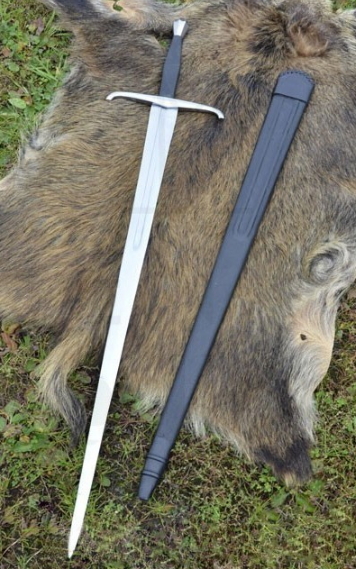
A practical example: the functional replica of an Italian one and a half hand sword inspired by a 15th-century original (on display at the Civic Museum L. Mazzoli, Brescia) shows how these modern techniques are applied. The blade is usually forged from high-carbon steel (in some cases EN-45 or equivalent steels) with heat treatment to obtain a working hardness — for example, around 48º HRC — which combines edge retention and flexibility. The blade screwed to the pommel and the octagonal leather-wrapped grip reproduce historical proportions and provide grip.
Common Materials and Finishes
- Steel: carbon steels like EN-45 or equivalents, hardened and tempered for balance between hardness and ductility.
- Hilts: wood covered in leather or traditional materials like ivory in original pieces; the pommel can be octagonal or with typical shapes of the era.
- Scabbards: wooden scabbard lined with leather with metal fittings at the ends for protection and aesthetics.
- Treatments: polished, blued, and finished to reproduce historical patinas or a modern shine according to the author’s intention.
Schools and Treatises: Why Technique is Part of the Legacy
Italian fencing is not an addition: it is the piece that explains why certain swords were designed as they were. Masters such as Ridolfo Capo Ferro and Salvatore Fabris codified movements, guards, and proportions that are still studied today by practitioners of historical martial arts.
Key Figures and Their Influence
- Ridolfo Capo Ferro (c. 1610): proposed relationships between sword length and the combatant’s stride, influencing the technical canon.
- Salvatore Fabris (1606): emphasized hip mobility and a more advanced stance, contributing tactics with rapier and dagger.
- Other masters: Agrippa, Giganti, Alfieri, Cavalcabo, di Grassi, and Lucino. Their manuscripts and engravings are an invaluable source for reconstructing technique and use.
Comparative Table: Lengths, Weight, and Purpose
| Type | Typical Length | Approximate Weight | Purpose |
|---|---|---|---|
| Cinquedea | 35–60 cm (blade) | 500–900 g | Civilian use, status, close-quarters cuts |
| Spada da lato | 90–110 cm (total) | 900–1.3 kg | Versatile: cutting and thrusting |
| Schiavona | ~105 cm (total) | ~1.1 kg | Military/mercenary combat, robust |
| Rapier | 100–140 cm (total) | 700–1.0 kg | Thrusting, civilian use and duels |
Historical Production Centers and Trade
Milan, Brescia, Serravalle, and Genoa were essential nodes in the steel and blade production network. Local forges and workshops developed a reputation for the quality of their steel and the skill of their swordsmiths. These blades circulated along trade routes that reached Spanish ports, explaining the influence and demand these weapons achieved throughout Europe.

How to “Read” a Replica and Verify its Historical Inspiration?
When observing a functional replica, look for signs of historicity: blade proportions, guard type, hilt material, and assembly method. Ask for technical data: steel used, heat treatment, HRC hardness, and whether the blade is screwed to the pommel — details that connect the replica to a specific forging tradition.
Real example: the Italian one and a half hand sword replica mentioned in archives shows: blade forged in EN-45 steel with heat treatment, hardness around 48º HRC, wooden hilt covered in leather, blade screwed to the octagonal pommel, and wooden scabbard lined with leather and metal protectors. These features combine maneuverability with historical fidelity.
Replicas and Functional Swords Inspired by Italian Models
The current replica market offers everything from purely decorative pieces to functional swords suitable for training and historical display. Functional replicas aim to reproduce dynamic behavior and aesthetics.
Italian Cinquedea Swords
Italian Rapier Swords
Maintenance, Safety, and Conservation
A well-preserved sword is a piece that will continue to tell stories. To maintain a functional replica in optimal condition, it is recommended to: clean it after use, apply protective oil to the steel, periodically check the assembly, and store it in a dry environment. Avoid prolonged humidity and contact with abrasive surfaces.
- Cleaning: wipe with a dry cloth after use and apply a light coat of mineral oil.
- Storage: in a horizontal position or hung with the blade protected; avoid wet leather scabbards for prolonged periods.
- Inspection: check the pommel screws, fastenings, and possible appearance of micro-cracks in the steel.
Cultural Value and Choosing for Your Collection
Beyond the physical object, Italian swords are symbols of a martial culture that links art, technique, and social status. When choosing a replica, consider its purpose: exhibition, practice, or historical recreation? That answer will guide the choice between decorative fidelity and functional performance.
Italian swords have traveled from the Renaissance squares to the manuals of fencing masters. Their legacy is technical, aesthetic, and commercial: blades forged in Italian cities that traveled throughout Europe, schools that defined the technique, and modern artisans who keep the flame of steel alive. Each piece, whether an ornate cinquedea or a robust schiavona, is a fragment of history that beats in the blade.
VIEW OTHER FUNCTIONAL SWORDS | VIEW CINQUEDEA SWORDS | VIEW ALL SWORDS
